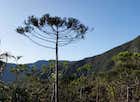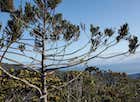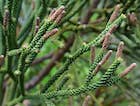
Trees in habitat, on ultramafic substrates on the trail up Mt Humboldt; iNaturalist observation 38112537 [Joey Santore, 2020.01.29]

Foliage, same site; iNaturalist observation 38112537 [Joey Santore, 2020.01.29]

Looking up into the crown, same site; iNaturalist observation 38112537 [Joey Santore, 2020.01.29]

Candelabra-shaped crown on trees in habitat [Adam Black, 2020.02.02, Facebook post].

Candelabra-shaped crown on trees in habitat [Adam Black, 2020.02.02, Facebook post].

Extremely young seed cones (flowers) on trees in habitat [Joey Santore, 2020.02.12, Facebook post].

Pollen cones on trees in habitat [Joey Santore, 2020.02.12, Facebook post].

Conservation Status

Dacrydium araucarioides
Brongniart et Grisebach 1866
Common names
Taxonomic notes
Syn: Podocarpus araucarioides (Brongniart et Grisb.) Sebert et Pancher (1874); Dacrydium arthrotaxoides Carrière (1867) (de Laubenfels 1972).
Dacrydium × suprinii Nimsch 2007 is a natural hybrid between this species and D. guillauminii.
Description
Small trees, 3-6 m tall, with a spreading crown usually assuming a candelabra form. Bark on mature trees thick, scaly, rough, dark brown and slightly fibrous inside, more or less smooth with occasional lenticels on young trees, becoming gray with age. Twigs short, thick, cylindrical. Juvenile leaves acicular, dense, curved, 12 mm long. Transitional leaves short and thick, 5-7 mm long (very similar to the adult leaves of Dacrydium balansae, but a little bit longer). Adult leaves develop gradually from the transitional leaves, scale-like, linear-oblong, about 3-5 mm long by 1-1.4 mm wide, densely overlapping in many rows, rigid, strongly curved, keeled beneath, blunt at the apex. Pollen cones terminal, often on short, lateral shoots, or laterally just below a terminal pollen cone, cylindrical, 9-18 mm long and 2.5-3 mm in diameter; microsporophylls long, triangular, sharp with incurved apex. Seed cone terminal on short branches whose leaves are about 3 mm long and strongly curved; bracts noticeably longer and straight on top of the cone, the apex slightly hooked, the entire cone becoming fleshy and red at maturity. Seeds 1-3, surrounded by the bracts, becoming erect and a little bit longer than the bracts which enclose them, oval but tapering off to a blunt apex, 4.5 mm long (Dallimore et al. 1967, de Laubenfels 1972). See García Esteban et al. (2004) for a detailed characterization of the wood anatomy.
Distribution and Ecology
New Caledonia. It is locally a dominant species in the vegetation on serpentine soils on the southern half of the main island from sea level to 1150 m above sea level (de Laubenfels 1972). Within its range, mean annual temperature is 21.2°C, with an average minimum in the coldest month of 14.2°C, and a mean annual precipitation of 1913 mm (Biffin et al. 2011, Table S5).
This map shows herbarium records of Dacrydium species native to New Caledonia. Blue is D. araucarioides, green is D. balansae, orange is D. guillauminii, and red is D lycopodioides. Click on an icon for further information. Distribution data from GBIF (2020.03.30), edited to remove duplicates.
Collections, all before 1972 except as noted, have been reported from the following locations:
- Massif de la Pourina near Yaté at an elevation of 300m above sea level (in 1993)
- Plaine des Lacs (15 collections)
- road to Mt. des Sources (6 collections)
- Yaté River (5 collections)
- Prony (4 collections)
- Mt. Dzumac (3 collections)
- Mois de Mai (3 collections)
- Marais Kiki (2 collections)
- Bois du sud (2 collections)
- Mt. Dore (2 collections)
- Blue River
- Peninsula Bogota, 500 m
- mountains below Canala
- summit of peak Foi
- Mt. Humboldt
- mountains below N'Goye, 1000 m
- Négropo
- Mt. Niocol
- upper Oiunné
- Mt. Ouénarou
- Pernod Creek, 170 m
- Pirogues River
- south of Poro, 600 m
- near Port Bouquet
- plateau north of Mt. Prokoméo, 700 m
- ridge north of Mt. Tonta, 950-1150 m
- upper Valley of Pines
The IUCN reports that the population status is stable.
Zone 10 (cold hardiness limit between -1°C and +4.4°C) (Bannister and Neuner 2001).
Remarkable Specimens
No data as of 2023.02.21.
Ethnobotany
No data as of 2023.02.21.
Observations
No data as of 2023.02.21.
Remarks
The epithet means "like Araucaria" and refers to the mature foliage.
Citations
Brongniart, A. and A. Gris. 1866. Sur Quelques Coniferes de la Nouvelle-Caledonie. Bulletin de la Société botanique de France 13:426 (1866). Available: Biodiversity Heritage Library, accessed 2021.12.19.
Knopf, P., H.Nimsch, and T. Stützel. 2007. Dacrydium × suprinii, sp. nova – a natural hybrid of Dacrydium araucarioides × D. guillauminii. Feddes Repertorium 118(1-2):51-59. Abstract: During excursions in New Caledonia in 1994, a hitherto undescribed natural hybrid between Dacrydium araucarioides Brongn. et Gris. and Dacrydium guillauminii J. Buchholz was found, for which the name Dacrydium × suprinii Nimsch sp. nova in honor of Bernard Suprin, Noumea, New Caledonia, is proposed. Morphological and site characteristics are presented.
Thanks to Ferenc Kiss for translating de Laubenfels from the French (2003.12).
See also
Association Endemia, a site devoted to New Caledonian species. Has excellent photos, a range map, and other information. In French.
Ann. Sci. Nat. Paris ser. 5, 6 : 244 (1866).
Nouv. Arch. Mus. Paris 4 : 5, tab 2 (1868).
Parlatore, in DC., Prodr. 16 (2) : 496 (1868).
Gordon, Pinetum ed. 2 : 103 (1875).
Pilger, in Engler, Pflanzenreich 4 (5) : 48 (1903).
Schinz & Guillaumin ex Sarasin & Roux, Nouv. Calédo. Bot. 1 :114 (1920).
Compton, Journ. Linn. Soc. 45 : 427 (1922).
Däniker, Mitt. Bot. Mus. Zürich 142 : 44 (1932).
Guillaumin, Acta Horti Gothob, 19 : 7 (1952).
Sarlin, Bois et Forêts Nouv. Calédo. : 91, tab, 17 (1954).
Laubenfels, D. J. de. 1969. Journal of the Arnold Arboretum. 50:296. Available: Biodiversity Heritage Library, accessed 2021.12.19.







